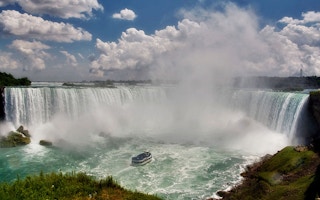Humanity got its first large-scale electricity thanks to hydropower. On August 26, 1895, water flowing over Niagara Falls was diverted to spin two generators, producing electricity to manufacture aluminum and carborundum. Since then, millions of dams have been built worldwide, transforming the energy of moving water into the energy of moving electrons.
When we need it, the water spins magnets past a coil of copper wire to give us heat, light and entertainment.
The basics of hydropower haven’t changed much in 120 years. But now scientists and engineers are taking a fresh look at hydropower to try to make it more environmentally friendly.
That’s because, while hydro provides 85 per cent of the world’s renewable electricity, it comes with a cost. Along with more commonly known issues such as habitat disruption, recent studies suggest reservoirs created by hydroelectric dams are a significant source of greenhouse gas emissions.
The U.S. Department of Energy is among those working to make hydropower better for the environment.
“Not only DOE, but really the entire hydro industry has agreed that more work needs to be done,” says Hoyt Battey, manager of market acceleration and deployment for the agency’s Wind and Water Power Technologies Office. “Hydro is going to continue to grow and has a lot of future opportunity that most people just aren’t aware of.”
“
Wind and solar have become cheaper in many countries, they are less risky in climate terms, they can be deployed more quickly, and they have smaller environmental and social footprints.
Kate Horner, executive director, International Rivers
Current global hydropower production is estimated at 1,700 gigawatts, providing about 2 per cent of total electric generating capacity.
In the U.S. — where in 2014 hydropower provided a little more than 6 per cent of total electricity generation and made up about 48 per cent of renewable generation, according to the DOE — hydropower capacity grew by 1.5 GW in the decade prior to 2015, reaching a total of 100 GW, according to the Energy Information Administration. (Wind, solar and natural gas capacity grew faster, while coal and oil declined and nuclear was essentially flat.)
In a Hydropower Vision report released in July 2016, the DOE estimates U.S. hydropower could grow a surprising 50 per cent by 2050.
Meanwhile, a 2015 study in the journal Aquatic Sciences estimated at least 3,700 major new hydroelectric dams are proposed or under construction worldwide, most in developing countries.
As a result of this surge in hydro development, an international coalition of governments, utilities and non-governmental organisations launched the Hydropower Sustainability Assessement Protocol in 2011.
These voluntary standards were created as a road map to make new hydropower more environmentally benign and less harmful to local communities, which are often displaced or compromised by large projects.
It remains to be seen how effective this effort has been. More than 60 other NGOs have criticised the protocol, saying it is not rigid enough to ensure sustainability goals are met and ignores a number of concerns, including ones related to human rights and the risk that dams could set off earthquakes.
Indeed, many environmental groups would prefer to see no new dams built. They argue other sustainable energy sources have evolved as better alternatives.
“Wind and solar have become cheaper in many countries, they are less risky in climate terms, they can be deployed more quickly, and they have smaller environmental and social footprints,” says Kate Horner, executive director of International Rivers.
This story was written by Matt Weiser for Ensia.com and was republished with permission. Read the full story.

















